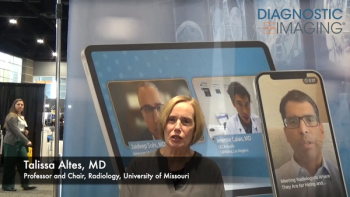
Technique reduces radiation exposure for CT colonography
A tube current modulation technique used for virtual colonoscopy reduces radiation exposure by one-third, and effective dose levels for the exam have remained constant despite the increased use of multislice technology, according to two studies presented at the 2004 RSNA meeting.
A tube current modulation technique used for virtual colonoscopy reduces radiation exposure by one-third, and effective dose levels for the exam have remained constant despite the increased use of multislice technology, according to two studies presented at the 2004 RSNA meeting.
Dr. Anno Graser and colleagues at the Ludwig-Maximilians University Munich screened 80 asymptomatic patients for colon polyps on a Siemens 16-slice CT scanner. Half the patients were examined with a standard protocol of 120 kVp and 120 mAs in the supine position and 40 mAs in the prone position. The other 40 patients were scanned using an online attenuation-based tube current modulation that adjusts the current over the patient's z-axis.
The researchers determined radiation exposure using the dose length product for both the supine and prone scans. They assessed image quality by determining Hounsfield unit measurements in the colonic lumen at four anatomic levels: porta hepatis, renal hilum, iliac crest, and acetabular roof.
Patients scanned with the tube current modulation technique had significantly lower radiation exposure in both positions than the other group: 4.24 mSv versus 6.55 mSv in the supine positon, and 1.61 mSv versus 2.38 mSv in the prone position.
Overall, radiation dose was reduced by 35% in the supine and 32% in the prone position, with no statistically significant difference in image noise at any of the four anatomic levels. The reduction of radiation exposure is particularly important for screening purposes, Graser said.
In a related study, Dr. Sebastiaan Jensch and colleagues from the Academic Medical Center in Amsterdam found that while the use of multislice scanners has increased, the effective doses associated with CT colonography have remained constant due to the use of lower dose settings.
The researchers searched the literature for CT colonography accuracy studies and then asked the institutions involved in those studies to provide their current scan protocol. They estimated the present-day effective dose using the CT dosimetry calculator, which allowed them to calculate doses from all scanner types.
The literature search revealed a median effective dose for a single CT colonography scan of 4.2 mSv (0.6 to 11 mSv). The median mAs was 88 (10 to 200 mAs), and the median collimation, 4.4 mm. Two-thirds of the scans were performed on a single-slice scanner.
Jensch and colleagues found little difference in effective dose for current scan protocols even though nearly 90% of virtual colonoscopy scans are now performed on multislice CT scanners.
The median effective dose for a single CT colonography at current protocol also was 4.2 mSv (1.2 to 11.7 mSv). The present median mAs value was 70 (20 to 200 mAs), and the median collimation was 2.5 mm.
If applied once to a population aged 50, CT colonography performed in supine and prone position will result in an estimated number of approximately one fatal cancer in 5000 individuals. It would become manifest after a long latent period, possibly decades, Jensch said.
For more information from the Diagnostic Imaging archives:
Newsletter
Stay at the forefront of radiology with the Diagnostic Imaging newsletter, delivering the latest news, clinical insights, and imaging advancements for today’s radiologists.




























